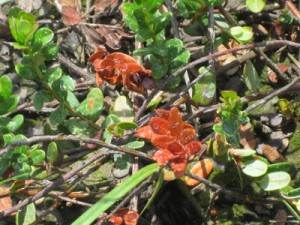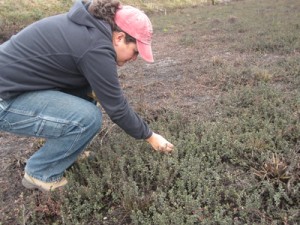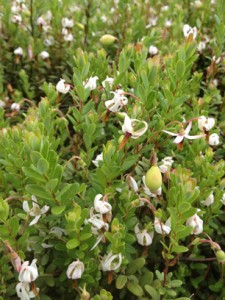“It’s not the heat, it’s the humidity.”
It may be a cliché, but it’s sadly all too true: thanks to New Jersey’s high humidity, the most serious disease problem faced by area cranberry growers is fruit rot. Though the fungi known to cause fruit rot appear wherever cranberries are grown, the degree of infection is greatly affected by weather conditions. Most field rot symptoms occur with high summer temperatures and moisture, per Dr. Peter Oudemans of the Rutgers Cooperative Extension.
We talked last week about how the weather has not been greatly beneficial for pollination; the same also applies to rot conditions. June 2013 has been the wettest June in recorded history in New Jersey, with an average rainfall for the month at 9.2 inches. According to PIICM manager Cristina Tassone, Pine Island received an average rainfall of eight inches both on the home farm and Sim Place. “In New Jersey, you have to have a fruit rot fungicide program,” she says. “And with weather conditions like this, we have to make sure our timing of the applications is right.” Fortunately, the newly installed underdrain is working very well to keep our bogs drained and as dry as possible, but we still need to use a treatment program. Our target percentage for rot is less than 3%; for anything higher than that, we are penalized by Ocean Spray. High rot numbers during the harvest hurts our efficiency. It slows down our packing house team, which in turn slows down the Ocean Spray receiving station.
Pine Island is constantly evaluating the fungicide program in order to make the best decisions from season to season. We don’t have hard numbers on rot percentage until after a bog is harvested, but every year at the end of harvest we always revisit and see if we need to adjust our program. We have two basic programs: standard and intensive. The standard is three to four applications. “The first two are the most important,” Cristina says. “We have to cover as many of the flowers as we can. Our team is constantly scouting until we get to about twenty percent scattered bloom, when the first application will go on, and then the next is done when we’re at full bloom. The first two are where you’re going to live or die.”
“Sad to say, this year we have ‘perfect’ rot conditions,” she says. “In a normal year, we can switch to the standard program from the more intensive program, but one year or one season can’t determine that. It’s all about timing; we do what we have to do when it’s time to do it. If it’s not done? You can’t turn that back.”



